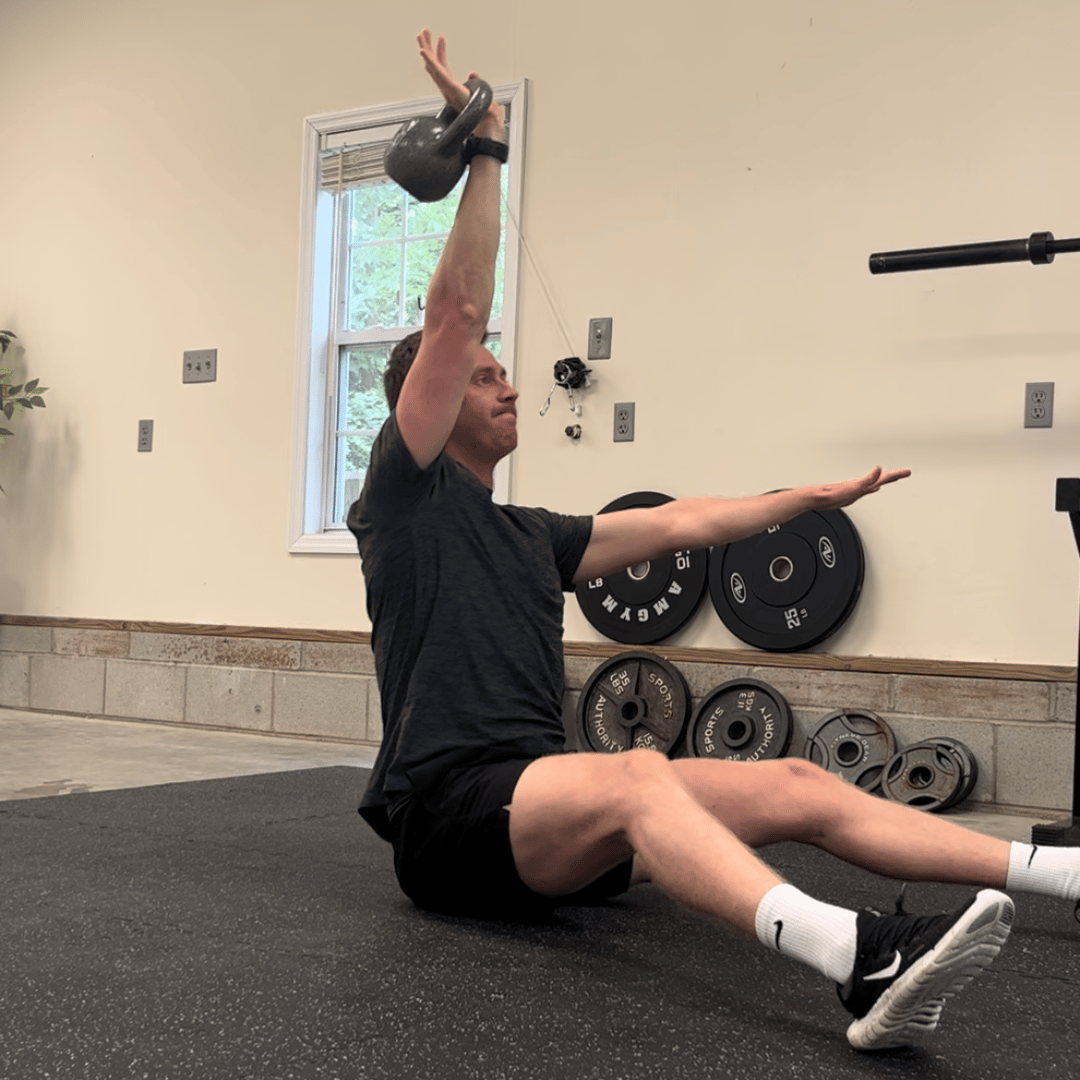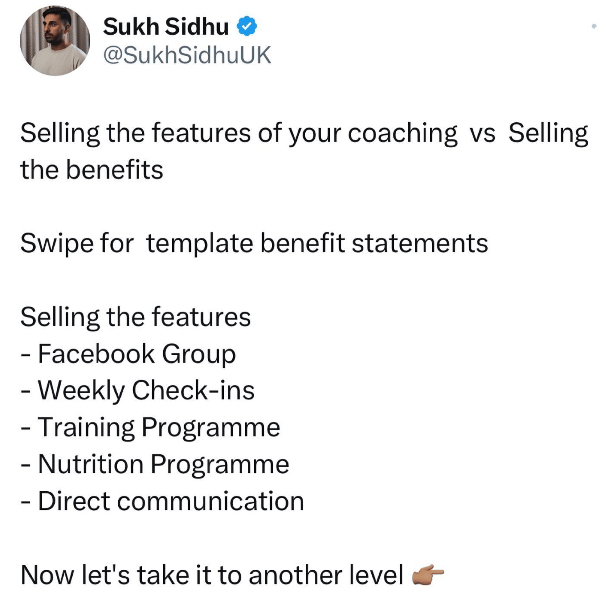- The Personal Trainer Roadmap
- Posts
- PTR #37 - How I programme for SGPT.
PTR #37 - How I programme for SGPT.
+ an alternative to sit ups & why you need to use more CTAs.
The PT Roadmap
A weekly newsletter for personal trainers to guide you to become a better coach and build a better business.
Hey!
Thanks for opening up today's newsletter. I appreciate you being here.
Nothing much is happening. However, I have been devouring a book called The Pillars of The Earth by Ken Follett. It’s easily up there with the best books I’ve ever read. If you’re looking for a fiction book you won’t want to put down, I’d recommend it.
In today’s issue:
✅ One business tip
✅ One coaching tip
✅ One exercise recommendation
✅ One coaching cue
✅ One social post worth your time
Let's get into it!
Better Business
If the following section feels familiar to you, I recently wrote it as a Twitter thread on Instagram.
My goal for the past month has been to sign up mentoring clients for my 1-1 service.
So, I've put out a lot of calls to action in my content and stories.
I've now got 10 clients.
Here's why this matters:
Too few PTs make it clear how to take the next natural step.
They put out good content but don't tell people what to do next if they want more.
They post pieces of social proof on their stories but leave money on the table by not asking interested parties to get in contact.
If you want clients, you must ask for them.
Regularly.
If you don't, you will drastically reduce your chance of getting any.
The simplest way is to tell people to message you.
For more information.
Or to state their interest in your trial, kickstart or programme.
Then, you can start the sales process more personally through messages.
The key point is:
If you want more clients, you must ask for clients. And you must do it often. At least 2-4 times per week.
Better Coaching
How I programme for SGPT.
I base my programming on a template.
I do it this way because:
It works for me and my garage gym (where I don’t have endless amounts of equipment)
I don’t find myself getting bored of coaching clients through it, and it saves me time
I can do my programming for SGPT in one 30-60 minute slot every 6 weeks.
You can do it any other number of ways, and you can use part of what I do and mix it in with what other people do.
Here’s the template:
5-7 min warm up. Basic movements, get the HR rate up, and some dynamic mobility.
First block (10 minutes)
A1 - Main Lower
A2 - Non-competing upper
A3 - Non-competing core or pre-hab
Second block (10 minutes)
B1 - Main Upper
B2 - Non-competing lower
B3 - Non-competing core or pre-hab
Third block (10 minutes)
C1 - Upper
C2 - lower
C3 - Non-competing core or pre-hab
5-8 minute finisher (if there is time)
Super simple.
I use timed blocks of 10 minutes (could be less or more) because this gives my clients more autonomy and allows me to focus on coaching.
My clients are explained and shown the 3 exercises, told the rep and set ranges and then told to work through it at their own pace. Some do 3-4 sets, and some 2-3 sets.
This leaves me the space to coach as needed without counting reps.
Then, when the 10 minutes are done, my clients write down their top set (e.g. back squats 65kg for 8 reps) in a small notebook. This means they’ve got a weight and rep to build from when they repeat that exercise.
Here’s a client notepad with their weight & reps recorded:

Note the 9/13 in the top right. I’ll never understand why Americans put the month before the day.
And here’s a recent example session:

I programme in 6-week blocks.
I only see my clients twice weekly, so I write two plans. One runs Monday-Wednesday and the other Thursday-Saturday.
I change out the third exercise often, and I vary the warm-up & finisher each week.
When I’m writing out a new plan, I’ll change up 50-60% of the exercises so it feels different but there is a level of stability.
Let me know if you’ve any other questions by hitting reply!
One Exercise Variation
Recommended Exercise: Single-Arm Kettlebell Sit-Up
Bored of programming regular sit-ups?
This one makes for a nice change.
I usually do it as part of a core circuit or as a filler exercise for a lower body movement that isn’t hugely reliant on the core (e.g. deads and squats.)
One Coaching Cue
Recommended Cue:
“Imagine you have chalk on your heel and a brick wall behind you. Use your heel to draw a straight line.”
What is it for?
Single-leg RDLs.
I love this cue as it’s so visual.
It often works well for the lowering phase of the lift.

One Social Media Post Worth Your Time
This is a great post from Sukh Sidhu on selling features vs. selling benefits.
99% of the time, you want to sell your service on its benefits.
Features add nothing.
Benefits make the features applicable.
I use the statement “so that” to make my features more enticing.
For example:
I do weekly 1-1 calls (the feature) so that you have someone you can ask questions, update on your progress, discuss challenges and stay accountable to (the benefit)
Thanks so much for reading.
Until next Friday, Stuart.
Here is how I help in-person PTs like you build businesses they love:
1-1 Mentoring
I work closely with in-person PTs to help them fix & grow their business so it’s filled with clients they love, profitable and rewarding.
This is 100% 1-1.
I don’t do group stuff.
I don’t have staff I pass you off to.
I don’t sell you one thing and give you another.
This is 1-1 mentoring where I work with you just like you do your 1-1 clients.
I’ll get to know you and your business before I offer any advice, and we’ll work together to make a plan that gets your business looking and feeling how you want it.
Then, we’ll talk on the phone every single week.
I don’t hold punches on these calls; you’re paying me for help and support. I'll tell you if you’re not doing something I think you should be. If your content isn’t good enough, I’ll tell you. If you tell me you want one thing but keep doing another, I’ll point that out.
Many PTs just need someone to tell them to do what they know they need to do. This is why it’s 1-1 and not a group because the 1-1 piece is essential to staying accountable and pushing things forward.
If you’re interested in chatting about how I can help, please reply, and we’ll set up a free 30-minute consultation.

